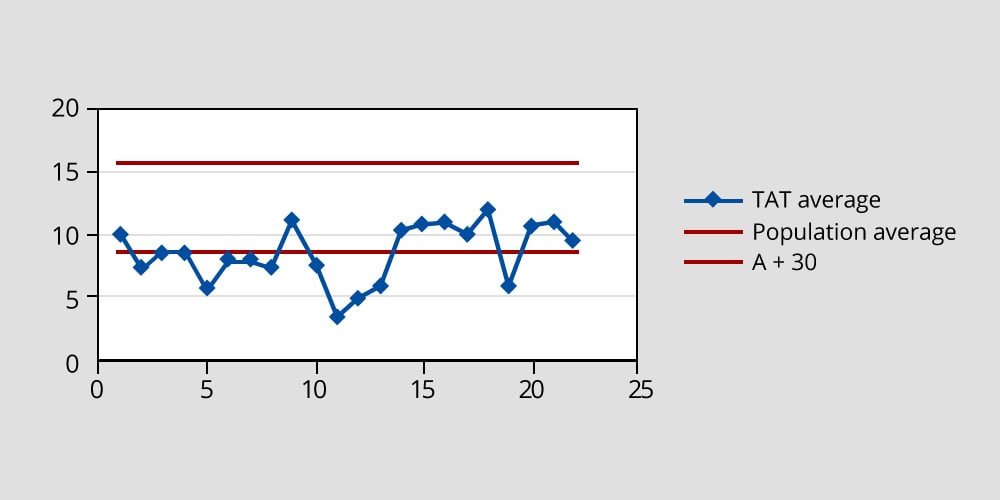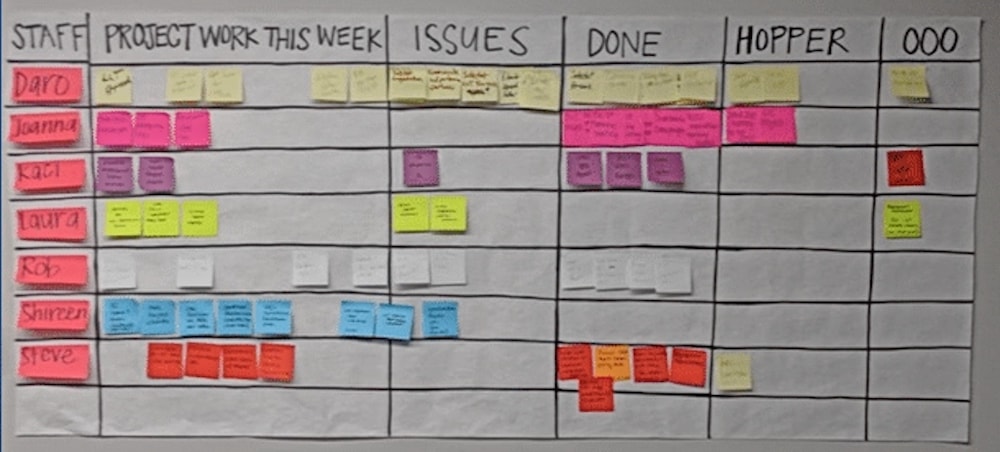Category: Case Studies

Case Study: Reducing Purchase Order Cycle Time, Part 1
Published:Using the DMAIC methodology, a Green Belt project aims to reduce the cycle time for purchase orders and straighten up a direction-less process.
Read more »
From Chaos to Order: Reinvigorating a City’s Finance Department
Published:The City of Fayetteville, North Carolina, faced a staffing crisis in its Finance department. Thanks to a DMAIC project, in just 14 weeks the City was able to turn the department’s chaos around.
Read more »
Creating Customer Delight – A Case Study in Diagnostic Clinics: Part 5 of 5
Published:In this continuation of a multi-part case study, recurring problems are identified and eliminated at the diagnostic clinics’ newly established centralized laboratory.
Read more »
Creating Customer Delight – A Case Study in Diagnostic Clinics: Part 4 of 5
Published:This now five-part case study focuses on improving customer satisfaction at two of a company’s diagnostic clinics – Centers A and B. In Part One, the company worked at Center A to reduce patient turnaround time, a defining component of patient satisfaction. In Part Two, the chain’s improvement story focuses on increasing patient delight at […]
Read more »
Case Study: Sime Darby Adds $250M with Lean Six Sigma
Published:Who Is Sime Darby Plantation? Sime Darby Plantation is the world’s largest sustainable palm oil producer and has four areas of focus: Upstream: 248 estates and 72 mills where fresh fruit is processed into crude palm oil Downstream: Production of oils and fats, oleochemicals, biodiesel, other palm oil derivatives and renewables in 16 countries Research […]
Read more »
Case Study: Use Category Resolution to Assess Gage R&R Results
Published:Although the gage reproducibility and repeatability (GR&R) study is a crucial tool in Six Sigma’s DMAIC (Define, Measure, Analyze, Improve, Control) toolset, it is not the most glamorous; mistakes in its execution are common among new Six Sigma practitioners. The standard for assessing if a gage is acceptable can vary significantly from organization to organization, […]
Read more »
Case Study: Optimizing Processes in Louisville, Kentucky
Published:Problem-solving teams are equipped to help leaders break through vexing operational challenges that impair customer satisfaction. Often, there are more challenges than resources, and staying focused on the most critical problems is imperative. This case study describes how a team redirected its efforts toward strategic needs. Original Team Purpose In Louisville, Kentucky, Greg Fischer, businessman […]
Read more »
Case Study: Optimizing Fuel Economy
Published:Late last year, I decided to upgrade my vehicle. For seven years I’d driven a Honda Civic. It was nothing special, just a reliable vehicle with good gas mileage – the perfect commuter car. But now I’ve got two kids, own a home and picked up woodworking as a hobby; fitting car seats and dimensional […]
Read more »
Case Study: Improving Value for Clients and Employees
Published:On her drive into work, Melissa Garcia was listening to Beethoven’s Piano Sonata No. 14 in C Sharp Minor and sipping on the mocha java blend she’d brewed in her kitchen just minutes before. It was a brisk fall Thursday morning, and Melissa was headed into the office where she was three weeks into her […]
Read more »
Case Study: Applying Resource Modeling to Server Migration
Published:Using resource models to balance staffing and skill sets can lead to higher service levels, lower costs and other benefits. A server migration example shows how this can work in information technology.
Read more »
Case Study: Using DFSS and DOE to Increase Product Reliability
Published:A medical devices company, developing technology to enable smaller medical devices, launched a substrate development effort as part of a larger-scale technology and product development effort. The substrate development effort involved predicting the stress caused by the laser welding process to ensure product reliability. In this Design for Six Sigma (DFSS) case study, design and […]
Read more »
DMAIC Case Study: Accuracy of System-generated Service Routes
Published:A leading environmental services company provides collection, processing, recycling and disposal of hazardous and non-hazardous materials for industrial and automotive customers. The company has branches all over the United States. The service representatives in these branches carry out services for geographically dispersed customers in their respective territories. This case study describes how DMAIC (Define, Measure, […]
Read more »
Case Study: Increasing Machinery Throughput Without More Machines
Published:Too often manufacturing operations are quick to look at a technological solution or other capital investment to solve a problem, when leaders already have all they need right in front of them. An investment in human capital can make quick gains for less money. Sticky Business Consider the following example. In the Midwest a manufacturing […]
Read more »
Case Study: Maximizing the Response of Fire Services to Medical Calls
Published:The City of Kawartha Lakes, Ontario, Canada, was formed in 2001 by a Provincial Order to amalgamate 16 lower-tier municipalities and one upper-tier county into one corporation. Although called a City, the municipality is mostly rural. The City is approximately 3,059 km2. Due to its large rural area, the City has 21 fire stations, comprised […]
Read more »
Case Study: Improving Recruitment Processes – Part 2 of 2
Published:In this case study, a team strives to improve the recruiting process in a large, fast-moving consumer goods company. Part 1 focused on reducing the recruiting cycle time. Part 2 focuses on decreasing the effort required to fill a job opening. The case described here uses total quality management (TQM) to address the problem of […]
Read more »
Case Study: Improving Recruitment Processes – Part 1 of 2
Published:In this case study, a team strives to improve the recruiting process in a large, fast-moving consumer goods company. Part 1 focuses on reducing the recruiting cycle time. Part 2 focuses on decreasing the effort required to fill a job opening. Rising attrition is a common problem across industries. Tight monthly, quarterly and annual objectives […]
Read more »
Case Study: Improving Purchase Order Process
Published:The accounts payable shared services center (SSC) of a large Ohio-based healthcare system completed a Six Sigma operational enhancement and reporting project. This case study reviews the course of the project which endeavored to establish standard invoice processing times and develop an ongoing system for monitoring how well those standards are met. Over the last […]
Read more »
Case Study: Reducing Turnaround Time of Lab Reports in the ICU
Published:A 250-bed hospital had implemented total quality management (TQM) to improve customer delight in its diagnostic clinics. After that success, the management team of the hospital was ready to proceed with further process improvement. After completing a brainstorming and prioritization exercise, the team determined to next address the problem: delay in receiving test reports for patients […]
Read more »
DMAIC Case Study: Improving System Availability
Published:A leading environmental services company applied the DMAIC (Define, Measure, Analyze, Improve, Control) methodology to improve the availability of an internal software system. The goal was to reduce system downtime (the time that the software application is not available for users) and reduce defect resolution time (the time it takes to fix a software defect […]
Read more »
Green Belt Project: Reduce Resolution Time and Rework in Software Development
Published:This article describes the successful implementation of a Six Sigma Green Belt project in information technology (IT) in which a software development team applied Six Sigma to reduce the resolution time of software defects and minimize rework, thereby increasing customer satisfaction. A software development team in a leading environmental services company wanted to reduce the […]
Read more »
Case Study: Use Six Sigma to Reduce Temporary Labor Expenses
Published:In any plant, when production increases above planned-for levels – whether due to sudden increased demand or unexpected constraints in the system – contract labor may be brought in as a quick fix. While this provides some flexibility in operations, increased labor costs is a problem. Six Sigma can be used to optimize these changing […]
Read more »
Improving the Productivity of a Service Team
Published:The manufacturing and transactional worlds have long used productivity as a measure of efficiency. Traditionally, a productivity metric has been used for assessing return on investment on machinery to measure the contributions of team members. In the growing service economy where human resources are the biggest driver of costs in the organization, management teams want […]
Read more »
FLEXcon: Lean for the Long Run
Published:The following are selected highlights of a corporate leadership profile of FLEXcon. The complete article – with more details about Lean application and how the company avoided layoffs during the recession – is available for purchase on the iSixSigma Marketplace. FLEXcon positions itself for growth by embracing Lean at every level More than 50 years […]
Read more »
Improving Outbound Calling Conversion Rates
Published:Internet betting exchange Betfair invests heavily in different marketing activities, and one of the most effective marketing channels is outbound calling. The outbound marketing team employs a number of different campaigns. Its main focus, however, is to reach out to customers who have registered online, but not yet placed money in their betting account. The […]
Read more »